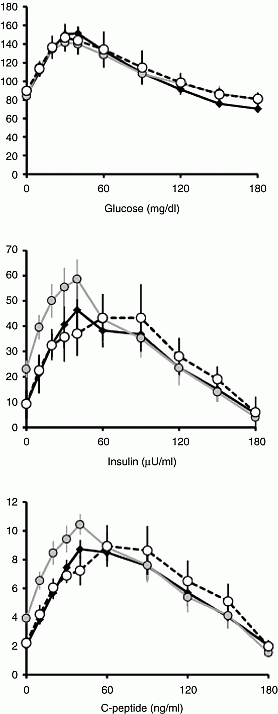ICEECE2012 Oral Communications Obesity Clinical (6 abstracts)
The Young Investigator Winner
M. Stadler 1, , L. Toman 1 , A. Storka 2 , M. Wolzt 2 , S. Peric 1 , C. Bieglmayer 2 , O. Wagner 2 , G. Pacini 3 , H. Brath 4 , P. Bech 5 , R. Prager 1 & M. Korbonits 6
1Hietzing Hospital Vienna, Vienna, Austria; 2Medical University Vienna, Vienna, Austria; 3Institute of Biomedical Engineering, National Research Council, Padova, Italy; 4Health Care Center Vienna South, Vienna, Austria; 5Hammersmith Hospital, Imperial College London, London, UK; 6Barts and the London School of Medicine, London, UK.
Despite the known health hazards of cigarette smoking, many smokers fail to quit smoking, mainly due to nicotine’s addictiveness, but also because of fear from gaining weight. However, the mechanism of weight gain after smoking cessation is not fully elucidated yet.
Healthy long-term smokers (28±2 years, 10F/20M, 23.4±1.3 kg/m2) participating in a smoking cessation programme underwent 3-hour oral glucose tolerance tests (oGTT) and body composition measurements while still smoking (Visit A; n=27) and after a minimum of 3 (3 m; n=14) and 6 months (6 m; n=8) of non-smoking. Fasting (QUICKI) and dynamic insulin sensitivity (OGIS) were calculated. First phase beta-cell secretion was calculated as the ratio of C-peptide and glucose areas under the curve in the first 40 min of oGTT (IGI40). Appetite was quantified with a free-choice-buffet. Fasting plasma concentrations of neuropeptide-Y (NPY), peptide-YY (PYY), glucagon-like-peptide-1 (GLP-1), leptin, ghrelin and visfatin were measured.
Body weight and fat mass increased after 3 m (+4% and +22% respectively) and after 6 m non-smoking (+5% and +35% respectively, P<0.05 vs baseline). Participants showed significant fasting insulin resistance (QUICKI: 3 m:0.37±0.02 vs baseline:0.41±0.2; P<0.05) at 3 m, but not at 6 m, while OGIS remained unchanged throughout. IGI40 increased by 31% after 3 m (baseline:0.299±0.11 vs 3 m:0.391±0.11, P<0.01), but reversed to normal after 6 m (0.265±5). Accordingly, carbohydrate ingestion was significantly increased after 3 m (3 m:500±39 kcal vs baseline:396±45 kcal; P<0.05), but not after 6 m. Fasting NPY was increased at 3 m (3 m: 0.41±0.03 ng/ml vs baseline:0.26±0.04 ng/ml; P<0.05), but not at 6 m. Interestingly, increased beta-cell-secretion at 3 m was less pronounced in participants finally succeeding to quit smoking for at least 6 m, as opposed to those relapsing after 3 m (P<0.05).
Smoking cessation leads to a transient increase of first phase beta-cell secretion in response to glucose, fasting insulin resistance and NPY plasma levels. These alterations could contribute to increased carbohydrate craving and consequent body weight gain after smoking cessation (Fig. 1).

Figure 1 Glucose plasma concentrations and insulin and C-peptide serum concentrations during the 180 min 75g oral glucose tolerance test in smokers (black) and after 3 (grey) and 6 months (white) of smoking cessation.
Declaration of interest: The authors declare that there is no conflict of interest that could be perceived as prejudicing the impartiality of the research project.
Funding: This work was supported, however funding details are unavailable.




